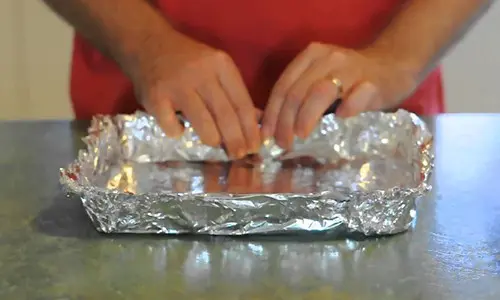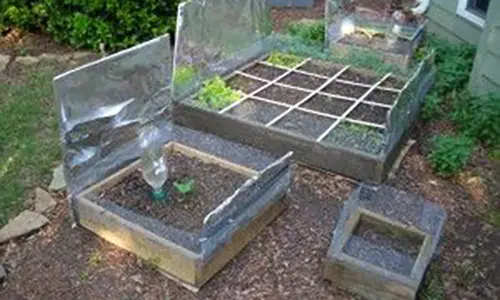Late last year, a freak hailstorm swept through my garden, unexpectedly damaging all of my young tomato plants. As I surveyed the wreckage, I thought all hope was lost for this season’s harvest.
But then I remembered something I had read online – that aluminum foil can help protect plants from severe weather.
In a desperate gamble, I fashioned makeshift shields around each of my damaged tomato plants with strips of foil.
To my pleasant surprise, within days, the plants had bounced back stronger than ever. That experience sparked my curiosity, which has led me to exploring other uses for aluminum foil in my garden/homestead.
Here they are:
1. Keeping rodents away from trees during winter
Use aluminum foil to protect your trees from rodents during winter, as they’re scared off by the metal’s feel and are unable to get through it. Take two layers of foil and wrap them around the base of your tree.
2. Making a funnel
Roll up foil into a cone and then funnel liquids into containers with small openings without spillage.
3. Keeping pests and slugs away
Aluminum foil creates a slippery surface that pests can’t climb up, protecting the plant from damage. The addition of foil strips to garden mulch also keeps pests away from plants.

4. Line the bottom of planters to improve drainage and prevent soil loss
The foil acts as a barrier to keep the soil from seeping out of the planter’s drainage holes while still allowing water to flow through.
5. Covering garden tables and benches to make cleanup easier
Aluminum foil makes cleaning up outdoor surfaces super quick and easy – simply crumple and toss after use.
6. Shielding seedlings from strong winds or cold temperatures
By creating an aluminum foil shield around the seedlings, they’re protected from harsh weather conditions until they’re strong enough to withstand them.
7. Sharpening your scissors
If you have dull scissors, try cutting through some aluminum foil. Start by folding foil into multiple layers then cut through it. Your scissors should be back to its initial sharpness after around seven passes through the foil.

8. Creating quick plant tags
Write on small pieces of foil and fold them around the plant stem to label plants in your garden.
9. Preventing weeds from growing
Lay aluminum foil on top of the soil and poke holes for desired plants. The foil will block out sunlight, preventing weed growth, while still allowing the preferred plants to grow through the holes.
10. Creating a DIY bird feeder
Wrap a piece of cardboard around a foil-covered tube to make a bird feeder to attract birds to your garden.
11. Deterring deer from eating your veggies
Wrap aluminum foil around sapling and shrub bases to deter deer from consuming your produce. Make sure the foil is at least 2-2.5 feet high (or waist length) because deer are particularly good at nibbling on plants that are less than their height.
Related: What To Do If You Find A Wild Boar On Your Property
12. Storing seeds in airtight foil packets
The foil will protect these seeds from moisture and air, keeping them fresh until planting time.
13. Creating an easy-to-clean drip tray under potted plants
Aluminum foil can help catch any excess water and soil, making it easy to tidy up after watering.

14. Encouraging root growth
Wrap the base of a plant stem with foil and bury it underground to reflect light and heat onto the soil, encouraging root growth.
15. Creating a makeshift watering can
Punch holes in the lid of a foil-covered jar to make a DIY watering can for watering small plants or areas.
16. Using foil to create a protective barrier around delicate plants during a storm
That protects plants from wind and rain damage.
17. Protecting garden tools from rust
Wrap your garden tools with foil when storing to help prevent moisture from reaching the metal, which protects tools from rust.
18. Reflecting heat onto food when smoking or grilling
Aluminum foil reflects heat onto the meat for even cooking and browning.

19. Make a sun box for seedling incubation
Indoors, plants tend to slant toward the light since it always comes from the same direction. Create a sun box to cover the other three sides. Cover the bottom of a cardboard box with aluminum foil, shiny side out, and tape or glue it in place. This will provide your plants light from all angles. Set the box near a window and fill it with plants.
20. Protecting outdoor electrical outlets from water damage
Wrap outdoor electrical outlets with foil to protect them from moisture and water damage.
21. Using it to reflect light onto solar panels, increasing their efficiency
The reflective properties of aluminum foil can help improve the effectiveness of solar panels, which cam increase the efficiency of your water pump.
Related: DIY Solar Lantern
22. Maintain the freshness of your fruits and vegetables
Wrap your veggies and fruits with aluminum foil and store them in the refrigerator to keep them crisp and fresh for longer.

23. Wrapping the base of tomato plants to prevent potato blight
Foil can help prevent fungal growth in tomato plants by blocking soil-borne diseases.
24. Creating a DIY birdhouse
Form a desired shape with foil and fill it with nesting materials to attract birds to your garden.
25. Reflecting light onto a pool area to warm up the water
The reflective surface of foil can help warm up a pool area by reflecting sunlight onto it.
26. Creating a shield against electromagnetic interference (EMI) from nearby power lines
You can use aluminum foil as a shield against EMI, helping to protect electronic devices and garden equipment.
27. Covering surfaces during messy DIY projects
Aluminum foil helps protect outdoor surfaces from paint drips or stain spills during DIY projects.
Related: 9 Cheap DIY Backyard Projects

28. Repairing small tears or holes in plastic greenhouse covers
Use aluminum foil to patch small tears or holes in greenhouse plastic coverings.
29. Making temporary planters
Shape the foil into any shape you like and fill it with soil to create small planters for temporary use.
30. Creating a reflective outline around garden paths to increase visibility at night
Use foil to create a reflective border around garden paths, making them more visible in low-light conditions.
31. Creating a reflective surface to increase sunlight exposure for plants in low-light areas
The shiny surface reflects sunlight onto nearby plants, helping them receive more energy and light for growth.

32. Creating a DIY scarecrow
If you’re worried that seasonal parakeets will destroy your fruits, the easiest way to deter them is with a little aluminum foil. Birds are instinctively fearful of flashy, noisy things. To increase the odds of determent success, it’s best to tie some foil strips to poles or tree branches – and for fun, add some spooky eyeballs.
33. Creating a quick-and-easy grill tray
Make a tray for grilling veggies, seafood, and smaller items with aluminum foil, which will help prevent them from falling through the grates.
34. Cleaning garden tools by scrubbing them with crumpled-up foil
Crumple aluminum foil and scrub away dirt and rust on garden tools.
35. Covering windows to regulate temperature and prevent overheating
The foil reflects sunlight, keeping the inside of the room cooler and more regulated. You can also do this to your greenhouse.

36. Moving furniture
You can avoid wasting money on furniture moving sliders by using this technique. If you wish to rearrange your sitting area but think it would be difficult to move your side table, slide some foil under the legs and begin sliding.
37. Lining ponds or water features to prevent leaks
You can use aluminum foil to line ponds or water features, providing a waterproof seal.
38. Keeping rabbits and other small animals out of garden beds
Create a barrier around garden beds, deterring animals from entering.
Related: Raised Bed VS In-Ground Gardens
39. Creating a reflective surface to attract pollinators
The foil attracts sunlight and creates a visual cue for bees and butterflies.

40. Protecting outdoor furniture from weather damage
By wrapping outdoor furniture with foil, you can help protect it from damage by extreme weather.
41. Create a makeshift “sandbox” for kids’ small-scale gardening projects
Use foil as a moldable material for kids to create small structures or planters.
42. Covering garden ornaments during winter storage
Use you roll of aluminum foil to protect delicate garden ornaments from dust and moisture during storage.
43. Creating a temporary rain shelter
Create a makeshift awning or shade structure using foil-covered poles or stakes that reflects sunlight and provides protection from the rain.
44. Create a reflective surface for solar ovens
The reflective surface of foil can help increase the temperature inside a solar oven, enhancing its effectiveness.

45. Keeping garden tools sharp
Wrap your freshly-sharpened garden tools with foil to help stop the edges from dulling.
46. Creating a barrier around compost piles to deter animals
Use aluminum foil to create a barrier around compost piles, preventing animals from digging through them.
47. Enhancing the effectiveness of homemade pest repellents
You can enhance the power of some pest repellents by adding foil to them, effectively reflecting light and repelling pests.
48. Using foil as a liner for car windshields during snow or ice storms
Use foil as a protective liner for car windshields, making it easier to remove snow or ice buildup.
49. Protecting outdoor speaker systems from moisture damage
By wrapping your outdoor speakers with aluminum foil, you can help protect them from moisture and air damage, extending their lifespan.
50. Improving garden lighting
Use a couple of strips of electrical tape or duct tape to secure the aluminum foil to the base of the inside of your light feature; however, avoid covering the bulb with tape.
It’s really fascinating to see how one simple household item can make such a big difference in your gardening experiences. But perhaps the most rewarding part of using aluminum foil for me is the sense of creativity and ingenuity that it inspires within me.
So which use are you most intrigued by? Please comment below.
You may also like:
 25 Practical Uses For Duct Tape Around The House
25 Practical Uses For Duct Tape Around The House
How To Make A Looters & EMP-Proof Shelter In Your Own Backyard (Video)
DIY Rope From Most Common Plants














